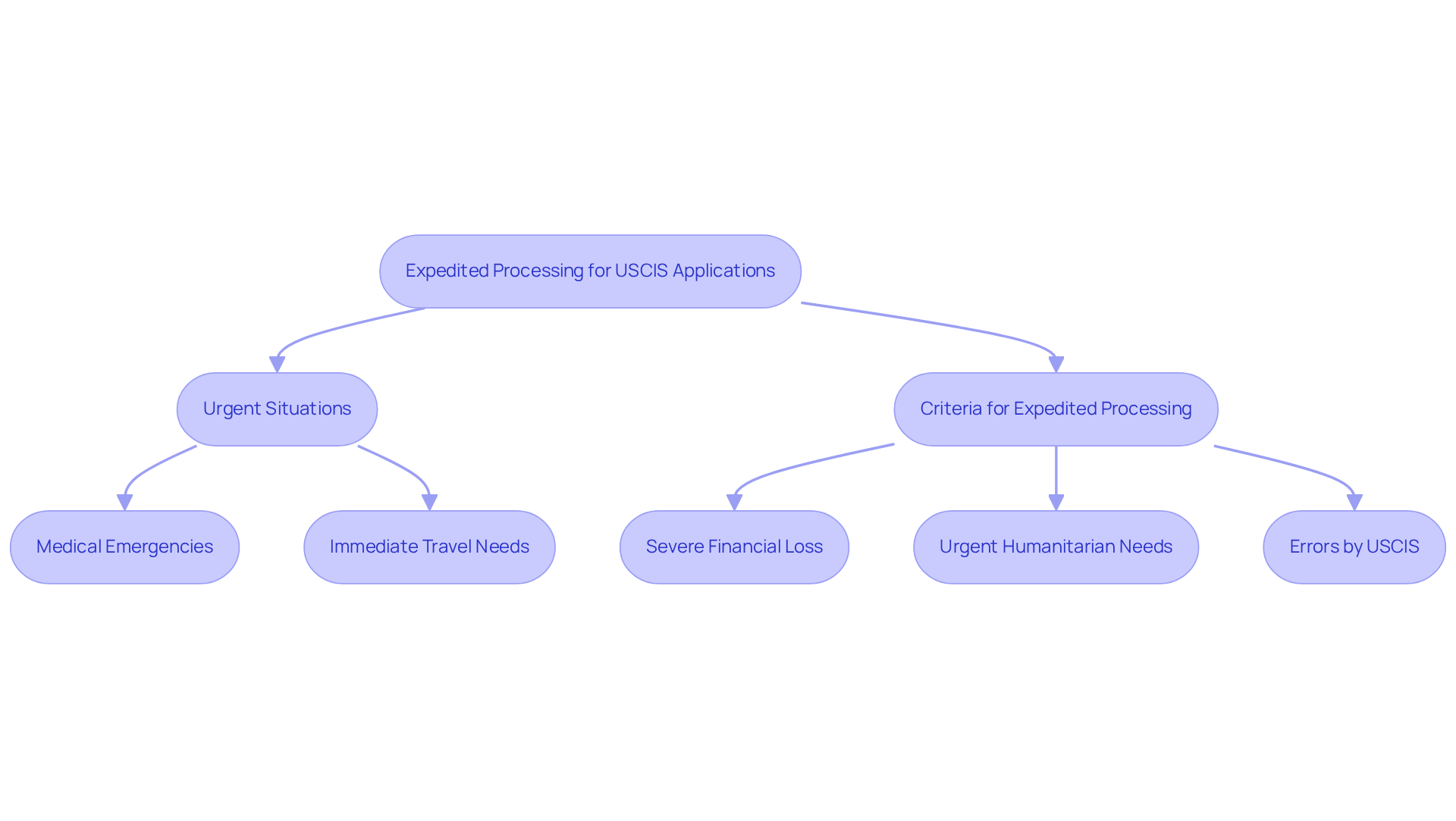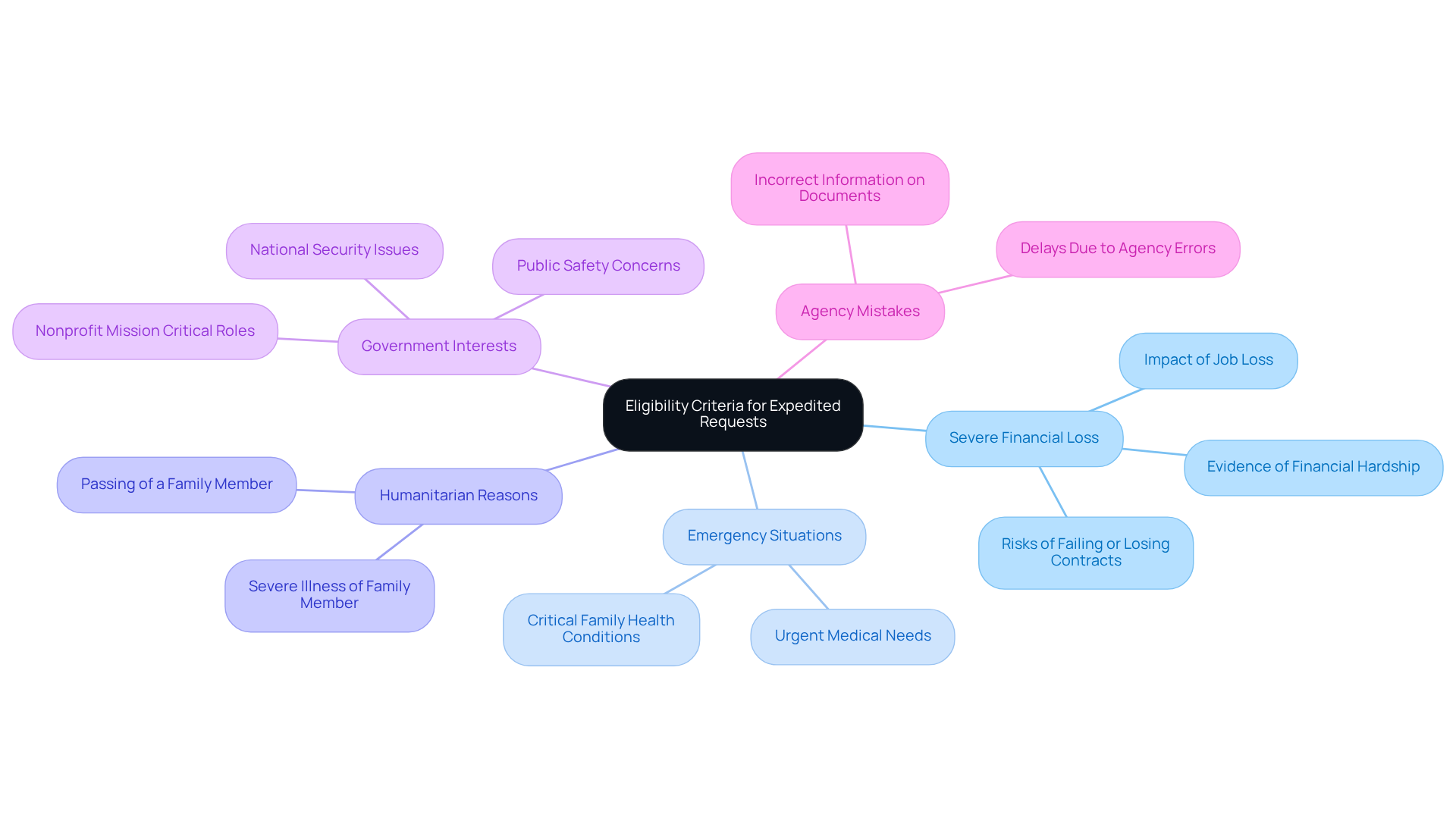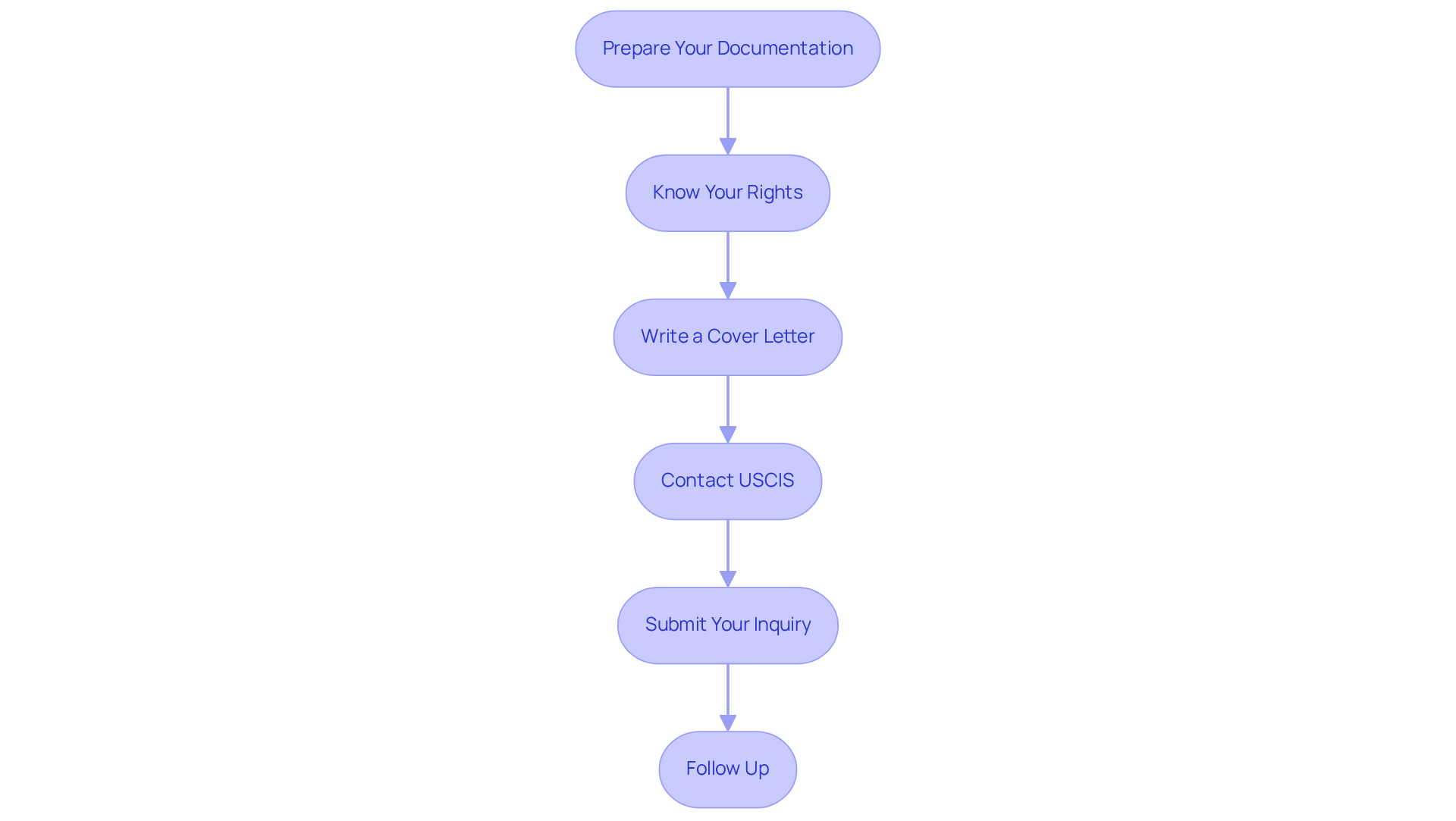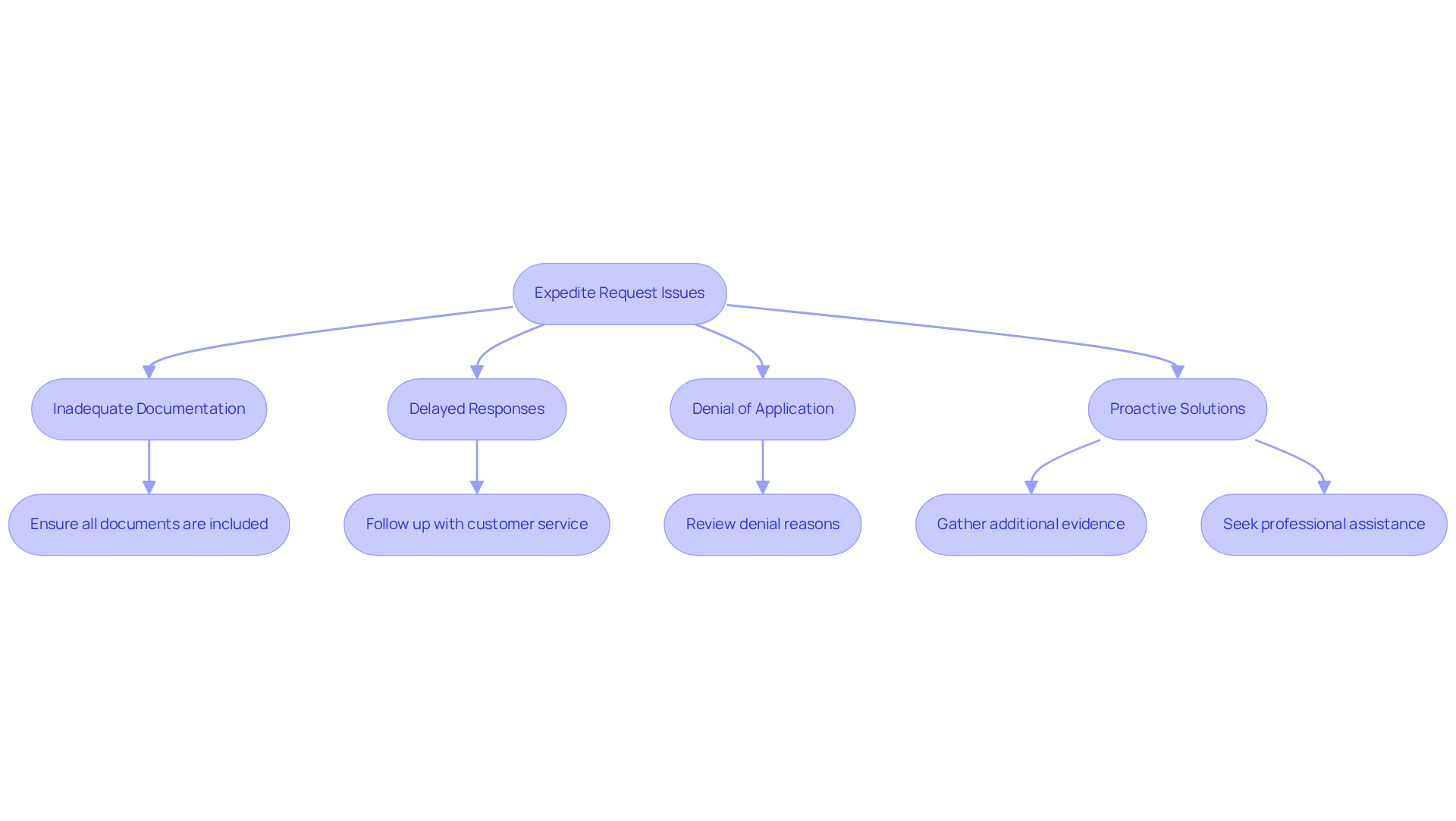Introduction
Navigating the U.S. immigration system can feel overwhelming, can’t it? When time is tight, the complexities can seem insurmountable. But here’s the good news: expedited processing offers a lifeline for those in urgent situations, paving a quicker path to crucial decisions on applications.
This guide is here to help you master the steps for expedited processing with USCIS. We’ll equip you with the knowledge to identify eligibility criteria and submit requests effectively. However, what if the road to expedited processing is filled with challenges? Understanding these nuances could be the key to turning prolonged uncertainty into swift resolutions.
Remember, you’re not alone in this fight. We’re here to support you every step of the way.
Understand Expedited Processing for USCIS Applications
Expedited processing is a vital service offered by the immigration agency, designed to help applicants receive quicker decisions on their applications, petitions, or inquiries. This service is especially beneficial for those facing urgent situations, like medical emergencies or immediate travel needs. Understanding the requirements for expedited processing is crucial, as it can significantly reduce waiting times compared to standard processing. Typically, fast-tracked requests are assessed based on factors such as severe financial loss, emergencies, urgent humanitarian needs, or clear errors made by USCIS.
Real-life examples showcase the effectiveness of accelerated handling. One client faced a medical crisis that necessitated urgent travel overseas; thanks to fast-tracked approval, their application was swiftly authorized, allowing them to address their pressing health needs without delay. In another case, a relative's serious health condition prompted fast-tracked handling, facilitating quick travel arrangements and highlighting the service's critical role in emergencies.
As of 2025, USCIS has updated its criteria for fast-tracked handling, adopting a more organized approach to evaluating requests. The approval rates for these expedited processing procedures remain promising, with many applicants successfully navigating the complexities of the immigration system. By familiarizing yourself with these standards and practical applications, you can better assess whether your situation qualifies for faster handling, ultimately boosting your chances of a timely resolution.

Identify Eligibility Criteria for Expedited Requests
To qualify for expedited processing, applicants must show that their case meets one or more of the following criteria:
-
Severe Financial Loss: You need to provide evidence that a delay would lead to significant financial hardship. For instance, consider a medical office facing layoffs due to a gap in employment authorization. This situation highlights how job loss can make prompt treatment essential.
-
Emergency Situations: This includes urgent medical needs or situations that require immediate travel, like a family member's critical health condition that demands swift action.
-
Humanitarian Reasons: If you’re dealing with pressing humanitarian issues, such as the passing or severe illness of a family member, you may qualify for accelerated handling.
-
Government Interests: Requests that align with urgent government interests, including public safety or national security, can also be prioritized. For example, cases where a beneficiary's role is crucial to a nonprofit's mission may receive special attention.
-
Agency Mistakes: If a clear mistake by the agency has caused a delay, you can seek expedited processing to resolve the issue. This might include situations where incorrect information was provided on an Employment Authorization Document.
Make sure to collect supporting documentation that clearly demonstrates your eligibility according to these criteria. Remember, USCIS assesses each application individually, and we’re here to support you every step of the way.

Follow Steps to Submit Your Expedite Request
To submit your expedite application, follow these steps:
-
Prepare Your Documentation: Gather all required documents that validate your qualifications for fast-tracked review. This may include medical records, financial statements, or letters from relevant authorities that demonstrate the urgency of your situation.
-
Know Your Rights: If you’re facing legal emergencies, like a subpoena or ICE enforcement actions, remember that you have the right to remain silent and the right to an attorney. Don’t open your door unless ICE has a warrant signed by a judge.
-
Write a cover letter that clearly expresses your desire for expedited processing. Include your case number, the reasons for your appeal, and any supporting evidence that highlights the pressing nature of your circumstances.
-
Contact USCIS: Reach out to the immigration services Contact Center at 1-800-375-5283 to inform them of your intention to submit an expedite application. This step ensures that your inquiry is on their radar.
-
Submit Your Inquiry: Depending on your application type, submit your inquiry either by mail or through your online account. Be sure to include all supporting documents along with your cover letter to avoid delays.
-
Follow Up: After submitting, frequently monitor your case status online and be prepared to reply quickly to any inquiries for extra information from USCIS. This proactive approach can help ensure a smoother experience.

Troubleshoot Common Issues with Expedite Requests
When submitting an expedite request, you might run into some common issues that can really affect your chances of success.
- Inadequate Documentation: It’s crucial to include all necessary papers that clearly show your qualification for faster handling. Missing or incomplete information can lead to significant delays or even outright denials of your request.
Your cover letter needs to clearly explain the lack of clear justification for why your case deserves expedited processing. Vague or generic reasons just won’t cut it and may lead to rejection. Be specific about your situation to strengthen your case.
-
Delayed Responses: If you don’t hear back from the immigration office in a timely manner, don’t hesitate to follow up. Reach out to their customer service or check your case status online to ensure your inquiry is being processed.
-
Denial of Application: If your expedite application gets denied, take a close look at the reasons provided by USCIS. This feedback is key to understanding what went wrong. You might have the option to submit a new application with additional evidence or contest the decision if applicable.
By recognizing these common issues and addressing them proactively, you can navigate the expedited processing request more effectively. Remember, you’re not alone in this fight-we’re here to support you every step of the way.

Conclusion
Understanding the complexities of expedited processing for USCIS applications is crucial for anyone facing urgent immigration needs. This service is designed to speed up decision-making, easing the stress that comes with long waiting periods - especially for those in emergencies or critical situations. By knowing the requirements and processes involved, applicants can boost their chances of getting timely help when it matters most.
The article highlights key eligibility criteria for expedited requests:
- Severe financial loss
- Emergency situations
- Humanitarian reasons
- Government interests
- Agency mistakes
Each of these factors is vital in deciding whether an application can be fast-tracked. It also stresses the importance of thorough documentation and proactive communication with USCIS to effectively navigate potential challenges.
Ultimately, mastering expedited processing can make a significant difference in urgent situations. By familiarizing yourself with the steps to submit an expedite request and understanding common issues that may arise, you can be well-prepared to advocate for your needs. Taking action and staying informed not only empowers you but also underscores the importance of timely support in the immigration process. Remember, we’re here to fight for your family.
Frequently Asked Questions
What is expedited processing for USCIS applications?
Expedited processing is a service offered by USCIS that allows applicants to receive quicker decisions on their applications, petitions, or inquiries, particularly in urgent situations like medical emergencies or immediate travel needs.
Who can benefit from expedited processing?
Individuals facing urgent situations, such as severe financial loss, medical emergencies, urgent humanitarian needs, or those needing to correct clear errors made by USCIS, can benefit from expedited processing.
What factors are considered for expedited processing requests?
Factors considered include severe financial loss, emergencies, urgent humanitarian needs, and clear errors made by USCIS.
Can you provide examples of when expedited processing was effective?
Yes, one example involved a client who faced a medical crisis requiring urgent overseas travel, and their application was swiftly approved through expedited processing. Another case involved a relative's serious health condition, which also necessitated quick travel arrangements.
Has USCIS updated its criteria for expedited processing?
Yes, as of 2025, USCIS has updated its criteria for expedited processing, adopting a more organized approach to evaluating requests.
What are the approval rates for expedited processing requests?
The approval rates for expedited processing remain promising, with many applicants successfully navigating the immigration system.
How can applicants assess if their situation qualifies for expedited processing?
By familiarizing themselves with the updated standards and practical applications of expedited processing, applicants can better determine if their situation qualifies for faster handling, increasing their chances of a timely resolution.




